



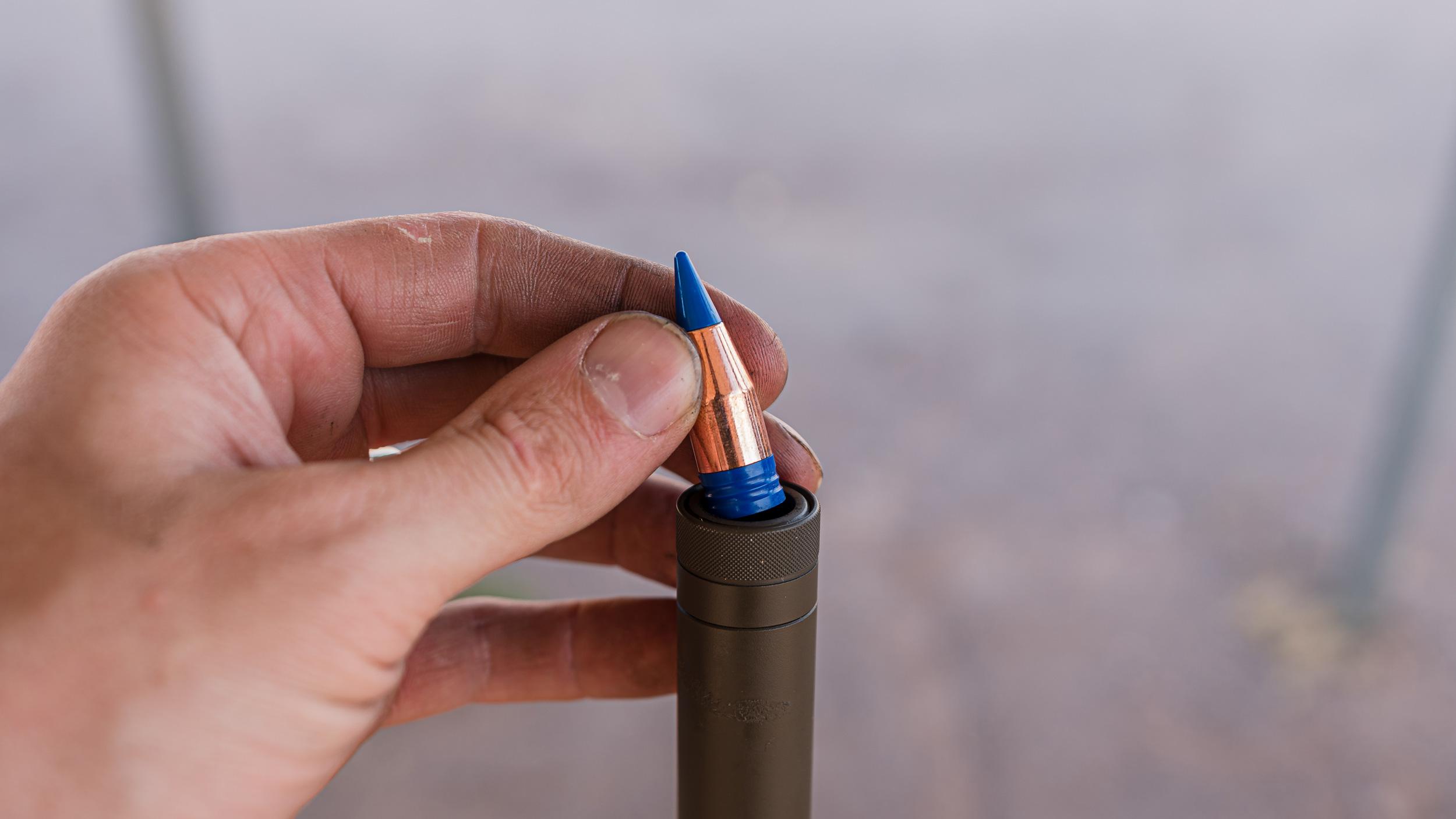
Powerbelt muzzleloader bullet for a Colorado legal hunting setup.
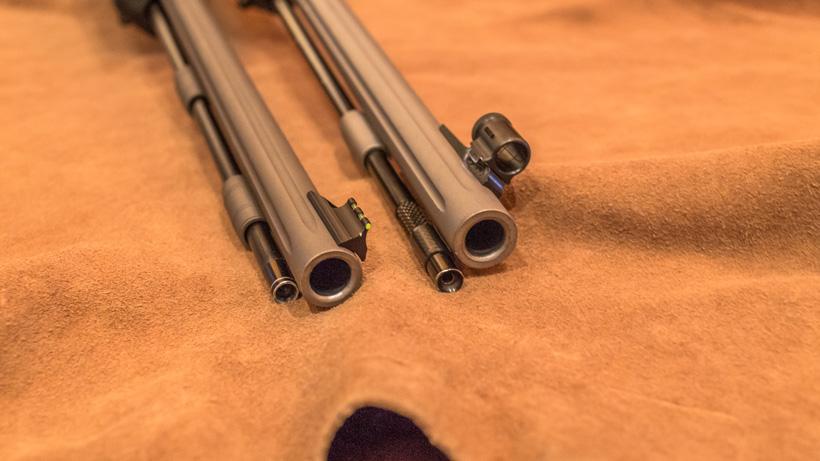
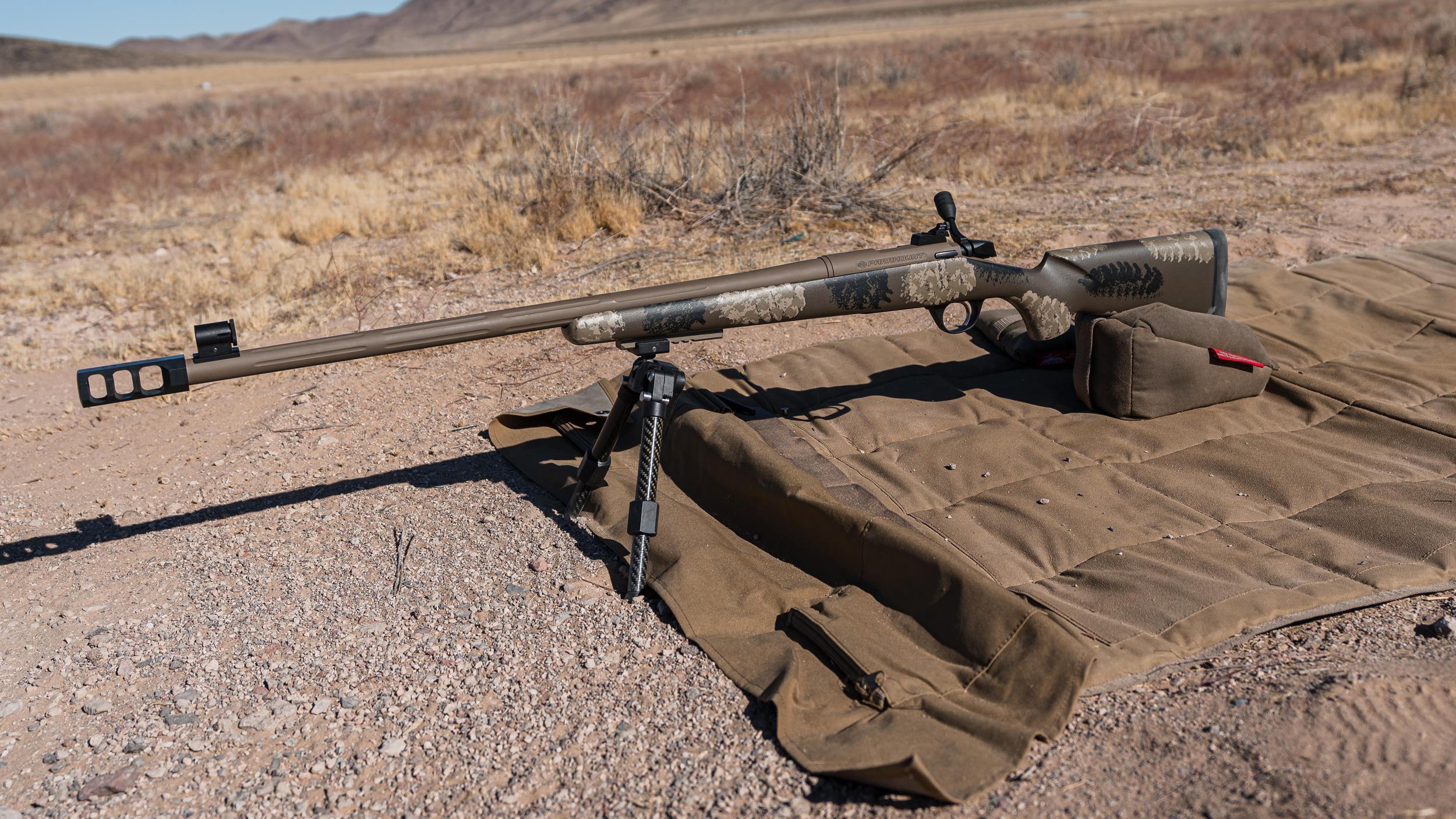
CVA Paramount Pro inline muzzleloader that is legal for hunting in many western states.
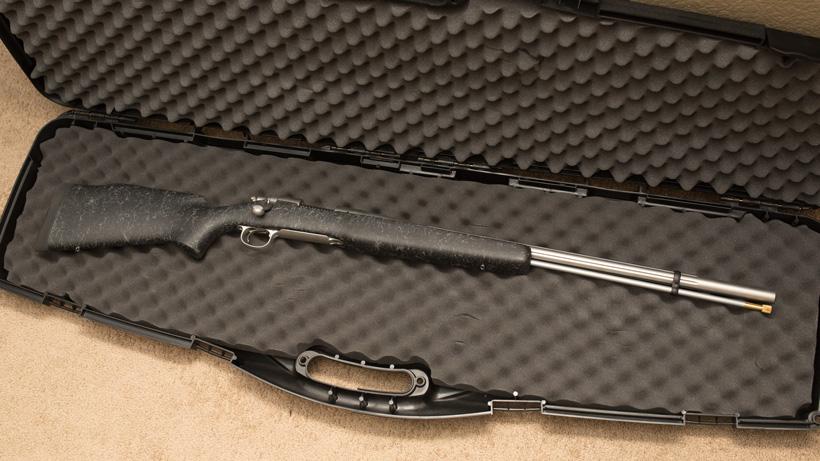
Muzzleloading component | Pelletized powders |
|---|---|
States where legal | Arizona, California, Iowa, Kansas, Nebraska, Nevada, New Mexico*, Utah, Washington, Wyoming |
States where illegal | Colorado, Idaho, Montana, New Mexico*, Oregon |
Muzzleloading component | Scopes (magnified) |
States where legal | Arizona, Iowa, Kansas, Nebraska, Wyoming |
States where illegal | California, Colorado, Idaho, Montana, Nevada, New Mexico, Oregon, Utah, Washington |
Muzzleloading component | 209 primers |
States where legal | Arizona, California, Colorado, Iowa, Kansas, Nebraska, Nevada, New Mexico*, Utah, Washington, Wyoming |
States where illegal | Idaho, Montana, New Mexico*, Oregon |
Muzzleloading component | Enclosed ignition |
States where legal | Arizona, California, Colorado, Iowa, Kansas, Nebraska, Montana, Nevada, New Mexico, Utah, Washington, Wyoming |
States where illegal | Idaho, Montana, Oregon |
Muzzleloading component | Sabots |
States where legal | Arizona, California**, Iowa, Kansas, Nebraska, Nevada, New Mexico*, Utah, Washington, Wyoming |
States where illegal | Colorado, Idaho, Montana, New Mexico*, Oregon |
Muzzleloading component | States where legal | States where illegal |
|---|---|---|
Pelletized powders | Arizona, California, Iowa, Kansas, Nebraska, Nevada, New Mexico*, Utah, Washington, Wyoming | Colorado, Idaho, Montana, New Mexico*, Oregon |
Scopes (magnified) | Arizona, Iowa, Kansas, Nebraska, Wyoming | California, Colorado, Idaho, Montana, Nevada, New Mexico, Oregon, Utah, Washington |
209 primers | Arizona, California, Colorado, Iowa, Kansas, Nebraska, Nevada, New Mexico*, Utah, Washington, Wyoming | Idaho, Montana, New Mexico*, Oregon |
Enclosed ignition | Arizona, California, Colorado, Iowa, Kansas, Nebraska, Montana, Nevada, New Mexico, Utah, Washington, Wyoming | Idaho, Montana, Oregon |
Sabots | Arizona, California**, Iowa, Kansas, Nebraska, Nevada, New Mexico*, Utah, Washington, Wyoming | Colorado, Idaho, Montana, New Mexico*, Oregon |
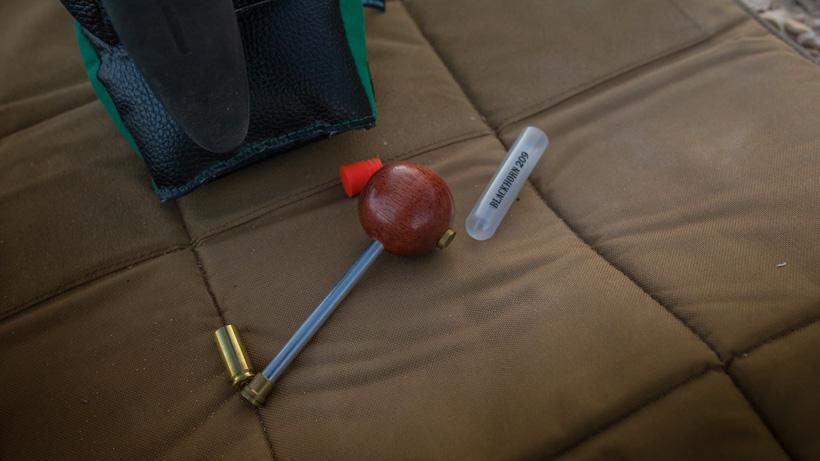
Caliber | .45 or .50 caliber |
|---|---|
Powder | Loose powder when necessary |
Projectile | Solid lead conical or sabot when legal |
Ignition source | Capable of being swapped between percussion caps and 209 primers |
Ignition style | Open style, this cannot be changed or altered on most firearms |
Optic | Open sights, or capable of removing scope when needed |
Caliber | Powder | Projectile | Ignition source | Ignition style | Optic |
|---|---|---|---|---|---|
.45 or .50 caliber | Loose powder when necessary | Solid lead conical or sabot when legal | Capable of being swapped between percussion caps and 209 primers | Open style, this cannot be changed or altered on most firearms | Open sights, or capable of removing scope when needed |
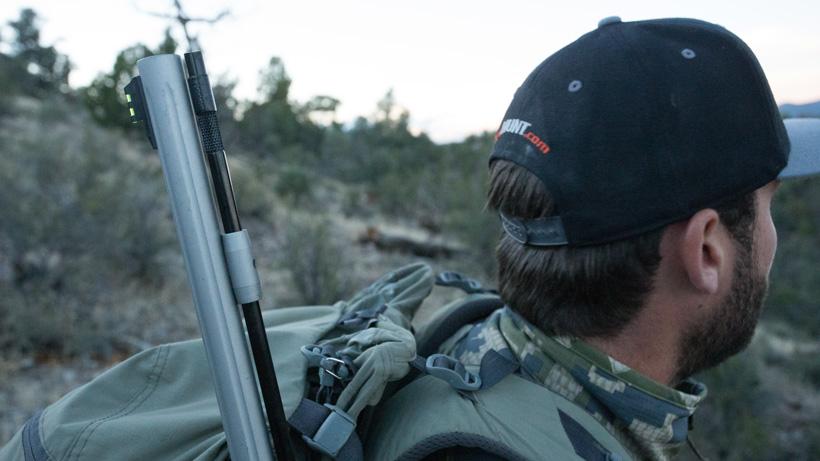
With point creep becoming an increasing issue across much of the West, many hunters are turning to weapon restriction seasons such as archery or muzzleloader hunts. These short-ranged weapons generally carry better draw odds for pulling a tag and can provide a new and unique experience. For many hunters, encountering the sheer number of muzzleloaders now on the market can be daunting from the get-go. And muzzleloader hunting regulations can be very confusing!
Beyond that, factor in some of the dizzying muzzleloader laws by each state, and searching for the perfect do-all muzzleloader can become a chore like no other.
In the following article, we will break down the specific muzzleloader regulations by each Western state that we cover on Insider as well as make sense of some of the terminology. This information will help when you consider not only what tag to apply for, but also will help you when building a muzzleloader that might work in several states.
Note: This article is a big collaborative effort between myself and Brady Miller, who contributed to it as well.
You can also quickly narrow down muzzleloader options in each Western state on Filtering 2.0. Once in Filtering, select a state, then species, and finally scroll down to "Select Season(s)" then select the Muzzleloader option.
Arizona offers muzzleloading options for mule deer, antelope, elk, and Coues deer. While Arizona is generally highlighted as a trophy state and carries notoriously low draw odds, archery seasons can generally be drawn with much higher odds than everything else. Those who select muzzleloader hunts will find better odds than in most rifle seasons.
There are no restrictions on optics, projectiles, or ignition sources. While this is a great fact for hunters in Arizona, it is important to note that a legal Arizona muzzleloader setup may not be usable in many other states. Consider your long-term goals when purchasing a muzzleloader to avoid the situation where a second firearm may need to be purchased.
California offers muzzleloader seasons for mule deer, Columbian blacktail, tule elk, and Roosevelt elk. Draw odds for some of the tags in California are generally lower than most states simply based on the extreme lack of opportunity. Still, drawing a coveted tag in California can oftentimes be made easier with the use of muzzleloaders.
California does carry some specific requirements for the use of muzzleloaders. As it reads in their regulations: “or wheellock, matchlock, flintlock or percussion type, including "inline" muzzleloading rifles using black powder or equivalent black powder substitute, including pellets, with a single projectile loaded from the muzzle and at least .40 caliber in designation.”
Here, it is important to note that all ignition sources and styles are legal, but the firearms must be at least a .40 caliber or larger. Considering a large portion of the muzzleloading market is comprised of .50 caliber options, this should be of little trouble.
The use of scopes or other magnified optics is prohibited in California unless a hunter has applied and been approved for the “Disabled Muzzleloader Scope Permit.” With the permit, accepted applicants can use a 1x magnification scope with crosshairs.
Another area of serious consideration when hunting California is that all fired projectiles must be 100% lead-free. This can narrow down your selection, but there are several great slugs and sabots being produced that are California-compliant.
Colorado offers muzzleloading opportunities for mule deer, elk, antelope, whitetail deer, moose, and black bear. Likely one of the states with the biggest example of point creep, many Colorado hunters are turning to muzzleloader seasons in an effort to draw a coveted tag. When looking, mule deer hunters will find better odds with muzzleloaders due to the fact that the season occurs in September, which is far from the rut, but deer can still be found in the high alpine basins at this time. The muzzleloader season for elk, on the other hand, aligns directly with the rut and will generally carry lower (worse) odds than a third rifle or fourth rifle season tag!
Idaho offers muzzleloader hunts for mule deer, elk, antelope, and whitetail deer. Unlike many of the western states, Idaho allows hunters to use several weapon types on the same tag during the same year, which can greatly increase opportunity. There are a number of controlled hunts available for each species, as well as a pile of over-the-counter (OTC) options that can drastically up your odds of punching a tag.
With some of the most strict muzzleloader regulations around, hunters in Idaho will need to pay special attention to the regulations.
You must use:
A rifle or musket that is capable of being loaded only from the muzzle and is at least forty-five (.45) caliber for deer, antelope, or mountain lion, or at least fifty (.50) caliber for elk, moose, bighorn sheep, mountain goat, or black bear.
NO electronic devices may be attached to or incorporated in the muzzleloader.
Short Range Weapons Seasons (Muzzleloader, Shotgun with slugs, Archery equipment, or Handguns firing straight walled pistol cartridges)
You may use:
Legal muzzleloaders include rifles, pistols, or muskets that can be loaded only through the front of the firing chamber with separate components and that fire a bullet of .40 inches in diameter or larger, using hard-cast solid lead, conical lead, saboted, or tumble-on-impact bullets.
Scopes of all magnifications are allowed on a muzzleloader in Kansas to hunt with.
Montana does offer a true muzzleloader-only hunting season option called the Heritage Hunting Season, which typically occurs in the middle of December each year. There are also some short-range weapon-restricted areas where muzzleloaders, shotguns, or handguns are legal for use.
In Montana, a traditional muzzleloader is loaded by pouring a pre-measured charge of loose (non-pelletized) black powder, loose pyrodex, or other loose black powder substitute down the bore.
Loose powder is a powder that has not been pre-formed into a pellet, stick, or other pre-made shape or charge. Loose powder is poured into a measuring device that measures the correct charge of powder and is then poured down the bore.
This is a bullet, conical, or round ball projectile that is made exclusively of lead. Bullets may not have any gas checks, sabots, or other manufactured range or power-enhancing additions. Round balls may be patched with a cloth patch. Note: There is no restriction on the rifling twist for the traditional muzzleloader season.
Systems that use a percussion cap mounted on the breech are not allowed. ln-line muzzleloaders and systems using shotgun or other primers are not allowed.
A percussion system uses an external hammer on the side of the muzzleloader tht strikes a percussion cap held on a nipple. Percussion caps come in several sizes #10, #11, musket cap, etc. Percussion caps must be used by placing the cap over a nipple and striking the cap/nipple with an external hammer. The cap must be struck with an external hammer mounted on the side of the firearm.
This system uses an external hammer to hold a piece of flint, agate, or other stone in the jaws. The hammer or cock, when released, strikes a frizzen and creates sparks. The sparks ignite a small amount of loose powder (priming powder) located in the pan, which sits adjacent to a hole in the side of the barrel called the touch hole. The incandescent heat from the burning priming charge ignites the main charge in the barrel.
A matchlock and wheelock ignition systems pre-date the flintlock system and are very primitive forms of ignition. Originals and replicas are very rare. If you have questions about using these types of firearms please contact the FWP enforcement headquarters.
Muzzleloader Heritage Hunting Season Lawful Weapons 87-1-304(9)
This information is directly from Montana Fish Wildlife and Parks: "Plain lead projectiles and a muzzleloading rifle that is charged with loose black powder, loose pyrodex, or an equivalent loose black powder substitute, and ignited by a flintlock, wheel lock, matchlock, or percussion mechanism using a percussion or musket cap. The muzzleloading rifle must be a minimum of .45 caliber and may not have more than two barrels. Additionally, 87-6-401(1), a hunter may not use a muzzleloading rifle that requires insertion of a cap or primer into the open breech of the barrel, is capable of being loaded from the breech, or is mounted with an optical magnification device. Use of prepared paper or metallic cartridges, sabots, gas checks, or other similar power and range-enhancing manufactured loads that enclose the projectile from the rifling or bore of the firearm is also prohibited."
You can find these Heritage Muzzleloader season dates using our Insider research platform. Once on Filtering, select Montana, then choose a species. You'll see those season dates for the Heritage Muzzleloader hunt.
Muzzleloader (this definition is strictly for the use of muzzloaders in weapons restriction areas. See the Muzzleloader Heritage Season Lawful Weapons section on page 24 for information regarding hunting during the heritage muzzloader season)
In Nebraska, for deer and antelope, muzzleloader handguns must be capable of delivering 400 foot-pounds of energy at 50 yards.
Muzzleloader rifles must be 44 caliber or larger, while muskets must be 62 caliber or larger and fire a single slug. Breech-loading (powder or bullet) muzzleloaders are not legal during the muzzleloader season.
Magnifying and variable power riflescopes are allowed to hunt big game. For elk and Rocky Mountain bighorn sheep, muzzleloading rifles must be 45 caliber or larger.
Scopes are legal for muzzleloader hunting in Nebraska.
Nevada offers muzzleloader seasons for mule deer, elk, and antelope. Due to its notorious trophy quality status, many of the top-tier tags found in Nevada can take a lot of years to draw. Muzzleloader tags in Nevada will see better draw odds than most rifle tags, albeit only slightly better. Still, better odds mean better odds.
New Mexico offers muzzleloading opportunities for mule deer, elk, antelope, whitetail deer, and Coues deer. Because New Mexico uses a random lottery draw that is not weighted with bonus or preference points, hunters can find some great draw odds. When looking at any particular species, pay special attention to the season dates for muzzleloaders. Some of the seasons may have more desirable dates than corresponding rifle tags and carry lower draw odds.
New Mexico recently passed a law that banned the use of magnified scopes on muzzleloaders in 2022, and the first full season of the magnified scope ban was in 2023, which will make these hunts more challenging. However, in time, it will likely allow more animals to reach an older age class, and those hunts should get better.
All the rules specify that hunters in designated regular muzzleloader hunts may not use scoped sights. Hunters may continue to use scoped muzzleloaders in “any-legal-weapon” hunts that are also open for use with centerfire rifles.
In New Mexico, muzzleloader requirements can be divided into two separate subcategories: regular muzzleloader hunts and restricted muzzleloader-only hunts.
When participating in standard muzzleloader season in New Mexico, hunters are allowed to use black powder, Pyrodex, or any black powder substitutes. Smokeless powder is prohibited. Scopes, sabots, and inline ignition systems are illegal.
Only a muzzleloader using open sights, black powder, or equivalent propellant and firing a full-bore-diameter bullet or patched round ball is legal. The use of inline ignition, scopes, and smokeless powder is prohibited. Bows and crossbows are legal during restricted muzzleloader deer hunts.
Muzzleloading long guns of .45 caliber or larger, and handguns .50 caliber or larger, having all of the components loaded through the muzzle, with flint or percussion ignition, firing black powder or black powder substitutes are legal.
Oregon offers muzzleloader hunts for mule deer, Columbian blacktail deer, Columbian whitetail deer, whitetail deer, Rocky Mountain, and Roosevelt elk, and antelope. Additionally, muzzleloaders can also be used during any of the 600 series weapons restricted hunts.
Utah offers muzzleloading seasons for mule deer, elk, and antelope. Because Utah is a choose-your-weapon state, many hunters will opt for an archery tag for the longer season dates or the rifle tag for the obvious range advantages. This can leave less competition during the muzzleloader-only season; however, the season is short, and it can be a tough time of the year to hunt for certain species. While most of the higher profile units will still carry steep draw odds for limited entry muzzleloader tags, a lot of great hunts can be found with good draw odds and great trophy qualities. Sometimes knocking 10” off of your expected trophy quality can yield draws odds 25% better or more when it comes to muzzleloader hunts in Utah.
New muzzleloader scope restrictions: The use of scopes stronger than 1x power are now prohibited on all muzzleloader hunts. Open sights, peep sights, a red dot, or a scope with a 1x power or less are still allowed. Any scope can still be used on a muzzleloader during an any legal weapon hunt. For full details, please see page 24 in the 2024 Big Game Field Regulations guidebook.
Check out our news article below:
No person can hunt, pursue, shoot or kill any big game with projectiles less than .44 caliber. Telescopic sights are not allowed.
Washington offers muzzleloader seasons for deer and elk, though other big game animals can be hunted with muzzleloaders during their general seasons. With Washington being a “choose your weapon state” many hunters may find less competition in the muzzleloading season as opposed to the general firearms season, although the challenges will obviously be higher.
Wyoming only offers a truly dedicated muzzleloader season for antelope. However, muzzleloaders are still useable during the any weapons season for those looking for an extra challenge. Anyone looking for a true muzzleloader hunt should save the effort for surrounding states.
“Muzzleloading rifle or handgun that is at least .40 caliber and fires a cartridge that uses lead or an expanding point bullet where the charge is at least 50 grains of black powder or its equivalent.”
When first looking at muzzleloader seasons and the firearms themselves, every hunter will be asking themselves, “Where do I even begin?” First, as stated before, I feel it is very important to consider where and what you will be hunting. What's legal in your home state may not be necessarily legal in other states, particularly those with strict muzzleloader regulations. Fortunately, today’s muzzleloaders are capable of using multiple ignition sources and can fire a multitude of projectiles accurately. Below, we will break down common denominators and establish what states allow or prohibit the use of each.
** California law requires that all projectiles be certified lead-free.
When looking at the above list, it is important to remember that many of the listed factors can be controlled on our end. For instance, scopes can be removed from guns, loose powder can be substituted for pellets, sabots can be exchanged for conicals, ignition sources can be changed from 209 primers to #10 or #11 caps, etc. So, the question really begs, “What is the ultimate do all muzzleloader for every state?” While there are many guns and manufacturers on the market, the list below will break down the requirements a muzzleloader must possess in order to be compliant across the West.
If any prospective firearms can answer “yes” to all of the above-listed criteria, then all that's left is developing a load before leaving for the hunt! Remember: many parameters of muzzleloading can be altered on any one gun to be compliant with any given state. The primary areas to focus on are caliber, adaptability of ignition sources, whether or not the ignition source is exposed, and whether or not you can swap between scopes and open-sight options.
You can also check out a few great articles by GOHUNT's Head of Research Brandon Evans, on extending the range of an open-sight muzzleloader:
Also, check out these articles Brady Miller wrote on muzzleloader tips:
Picking up a muzzleloader can not only greatly expand your western hunting opportunities but can also be a lot of fun! Modern muzzleloaders are capable of some remarkable accuracies and can be as complex or as simple as the user decides. Consider adding to your arsenal and go from drawing a tag every four to five seasons to hunting with at least one of your weapon choices every year!
This article was originally published on August 24, 2018, but has been updated several times as new changes to state regulations have occurred.
A muzzleloader is a firearm intended to be fired from the shoulder
Must be incapable of firing fixed ammunition
Must have a single barrel and single chamber
Must be loaded from the muzzle end of the barrel only
Must be ignited with black powder or synthetic black power
Must only fire a single projectile
Only legal muzzleloaders are allowed during muzzleloader seasons
Inline muzzleloaders are legal
Must be a single barrel that fires a single conical projectile or round ball
For deer, antelope, and bear, a conical projectile must be at least .40 caliber, and a round ball must be at least .50 caliber
For elk and moose, conical bullets must be at least .50 caliber, and round balls must be at least .54 caliber
From .40 to .50 caliber, bullets or round balls must weigh at least 170 grains
If greater than .50 caliber, a bullet or round ball must weigh at least 210 grains
209 Shotshell primers and B.O.R Lock MZ System bullets are legal
Pelletized powder systems are prohibited during muzzleloader seasons
The muzzleloader cannot be loaded from the breech during muzzleloader seasons
Only open or iron sights are legal during muzzleloader seasons. Sights using fiber optics or fluorescent paints are legal. Scopes or sights using artificial light, batteries, and other electronics are prohibited during muzzleloader seasons.
Sabots are prohibited during muzzleloader season. Cloth patches are not considered sabots. Bullet designs such as the Powerbelt are legal for use.
Smokeless powder is prohibited during muzzleloader seasons. True black powder or black powder substitutes are legal.
Electronic or battery-powered devices cannot be attached or incorporated into a muzzleloader during muzzleloader seasons.
Be capable of being loaded only from the muzzle
Be equipped with a single or double-barrel
Minimum caliber:
Equipped only with open or peep sights
NO electronic devices may be attached to, or incorporated in, the muzzleloader
Load only with loose black power, loose pyrodex
ex, or loose black powder substitutes (pelletized powders including pellets, or firesticks are prohibited)
Loaded with a patched round ball or conical metal or metal alloy projectile with the exception of allowance of accuracy tips and pressure bases
All Power Belt brand and similar bullets are allowed
Loaded with a projectile that is within .010” of the bore diameter
Equipped only with a flint, percussion cap, or musket cap
Equipped with an ignition system in which any portion of the cap is exposed when the weapon is cocked and ready to fire
Scopes - with, or without, lighted reticles
Any type of ignition system, including closed breech systems using 209 primers
Any type of muzzle loading powder, including loose, pellets, and powder sticks
Any type of hammer, including plunger or bolt style inlines
Any type of bullet, including sabots
Only muzzleloading rifles, muzzleloading muskets, muzzleloading pistols, and muzzleloading revolvers between .44 and .775 of an inch shooting a single projectile
Muzzleloaders equipped with electronic ignition are not allowed
Inline and disk-type muzzleloaders are allowed
Riflescopes may also be used
Scopes are not allowed;
Must be a minimum of .45 caliber;
Must have no more than two barrels;
Must only use plain lead projectiles;
Must be charged with loose black powder, loose pyrodex, or an equivalent loose black powder substitute;
Must be ignited by a flintlock, wheel lock, matchlock, or percussion mechanism using a percussion or musket cap;
May not use a muzzleloading rifle that requires insertion of a cap or primer into the open breech of the barrel and you cannot use a muzzleloader that is capable of being loaded from the breech;
Use of prepared paper or metallic cartridges, sabots, gas checks, or other similar power and range-enhancing manufactured loads that enclose the projectile from the rifling or bore of the firearm is also prohibited
Must not be capable of being loaded from the breech of the barrel
May not be loaded with any pre-prepared paper or metallic cartridges
must be charged with black powder, pyrodex, or an equivalent
Must be ignited by a percussion, flintlock, matchlock, 209 primer, or wheelock mechanism
Must be a minimum of .45 caliber
May have no more than two barrels
Have a single barrel of .45 caliber or larger.
Use a wheel-lock, flintlock, matchlock, or percussion ignition system that uses a primer or percussion. Inline muzzleloaders are permitted.
Be loaded with a lead ball, lead bullet, semi-jacketed bullet or a metal alloy bullet that expands. A saboted bullet may be used.
Be equipped with only open sights or peep sights. Scopes, battery-powered sights, electronics, or radioactive isotopes such a tritium are prohibited.
Be capable only of using black powder or black powder substitutes.
Note: Per NAC 503.146, the Department may issue a scope permit to a person with a visual disability which will authorize the use of a 1x magnification scope during a hunt that is restricted to archery or muzzleloading weapons only. Applications must be submitted to the Department on a form provided by the Department.
Sporting arm in which the charge and projectile(s) is loaded through the muzzle.
Only blackpowder or equivalent blackpowder substitute may be used.
Sabots and inline ignition may be used with muzzleloaders except during restricted muzzleloader deer hunts.
Use of smokeless powder is prohibited.
Only open or "iron" sights may be used on muzzleloader.
Scopes, red dots, or other similar sights are not allowed.
Be loaded only from the muzzle end of the barrel
Use only black powder, or equivalent blackpowder substitute may be used
The use of smokeless powder is prohibited
You CANNOT use an inline ignition system
Must use full-bore-diameter bullet or patched round ball. No use sabots or belted projectiles is legal.
Be fitted only with open sights. Scopes, red dots, and all optical sights are prohibited.
Be capable of only firing one projectile.
Smokeless powders are not legal
Telescopic sights are prohibited
No magnification (1x) scopes are legal
Scopes and sights that use artificial light or energy are prohibited except for visually impaired hunters where a permit is required for use. Open and peep sights that are made of alloys, plastic or other materials that do not have any of the above properties are legal. The use of fluorescent paint and fiber optics on these sights is allowed.
It is illegal to hunt with jacketed bullets, sabots and bullets with plastic or synthetic bases or tips.
Allowable projectiles include round balls made of lead, lead-alloy or federally approved non-toxic shot material used with cloth, felt, or paper patches. Conicals made of lead or lead alloy may be used, but the length of the bullet may not exceed twice the diameter. Lead-free conical bullets may also be used providing their length does not exceed twice the diameter.
The use of 209 shotgun primers is prohibited as an ignition source, and the ignition itself must be open to the elements.
Pelletized powders are prohibited. Loose granular black powder or black powder substitutes are legal.
Muzzleloaders with revolving actions are prohibited.
Must be capable of only being loaded from the muzzle;
Can use open sights, peep sights, and 1x riflescopes;
Must have only a single barrel which measures 18” or greater; and
Must not be capable of being fired more than once without being reloaded.
The powder and projectile may not be bonded together as one unit for reloading purposes.
Must be only loaded with black powder or any black powder synthetic.
Projectiles must be lead or capable of expanding, and at least .40 caliber.
For deer and antelope projectiles: must be at least 130 grains or 170 grains if using sabots.
For elk, moose, bison, bighorn sheep, or mountain goat projectiles: must be at least 210 grains or 240 grains if using sabots.
Only be loaded from the muzzle
Must use black powder or a black powder substitute
Must have a single or double barrel that is either rifled or smooth bore
Must be .40 caliber or larger for deer and .45 or larger for all other big game. #1 buckshot may be used for deer in muzzleloaders .60 caliber or larger
Have an ignition source that is either wheellock, flintlock, matchlock, or percussion (primers designed to be used in modern cartridges are legal)
Have open, peep, or other open-sight designs. Fiber optic open sights are legal. Telescopic sights or sights containing glass are prohibited
Not have any electronic devices attached to the muzzleloader
Have a single or double barrel of at least 8 inches in length
Have a rifled barrel
Be capable of being loaded with 45 grains of black powder or a black powder substitute
Be .45 caliber or larger for all big game
.45 caliber or greater for deer, antelope, mountain lion, or wolf
.50 caliber for elk, moose, bighorn sheep, mountain goat, or black bear
Any scopes are prohibited
Except hunters with a visual disability may apply for a Reasonable Modification Permit to use non - magnifying or up to 4x power scopes. Application available at Fish and Game regional offices
Sabots are prohibited
209 shotgun primers are prohibited
Northwest inline models are allowed
Note: scopes are permitted only during an "any legal weapon" hunt
Scopes stronger than 1× power on muzzleloaders for all muzzleloader hunts will be prohibited and applies to all big game muzzleloader hunts, including general season, limited-entry, management, and handgun-archery-muzzleloader-shotgun-straight-walled-rifle-only hunts. Scopes of any power will still be allowed on muzzleloaders during any legal weapon hunts. Visual impairment certificates of registration for scopes would still be allowed. This means that, otherwise, only open sights, peep sights, a red dot, or scopes with 1× power or less will be allowed on muzzleloaders in those hunts.